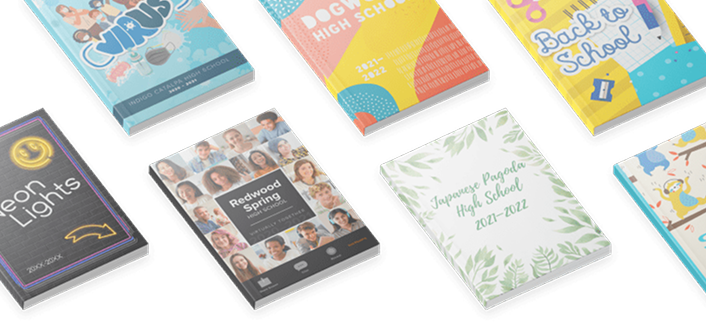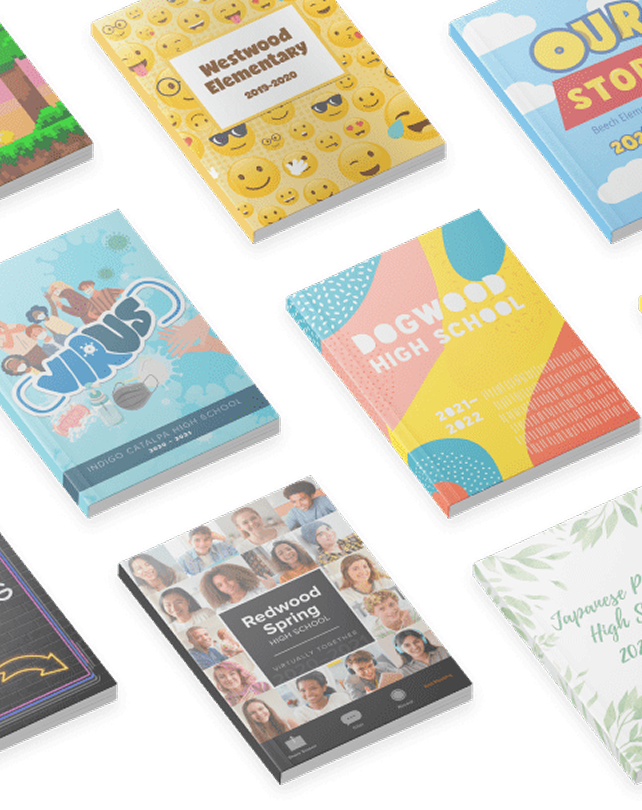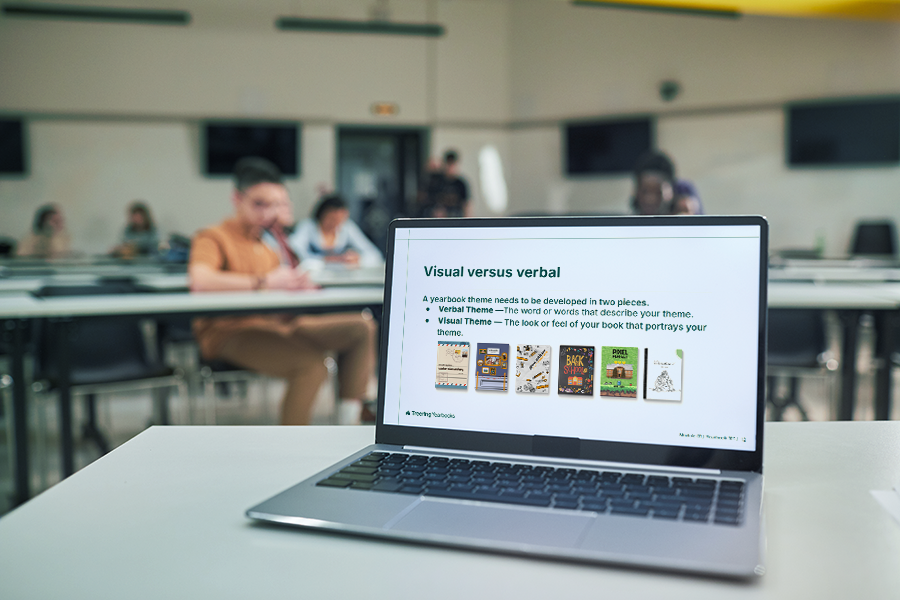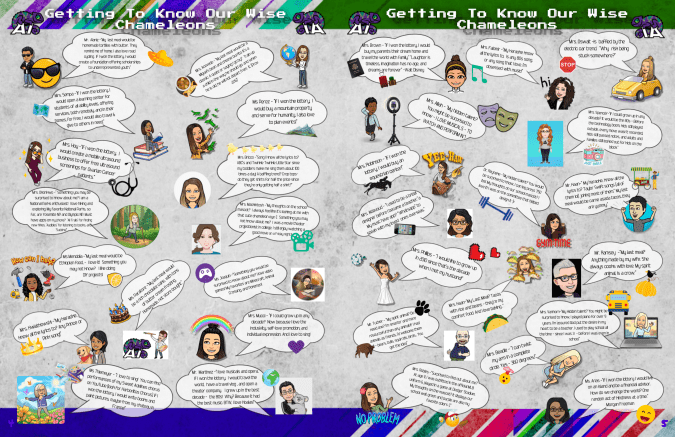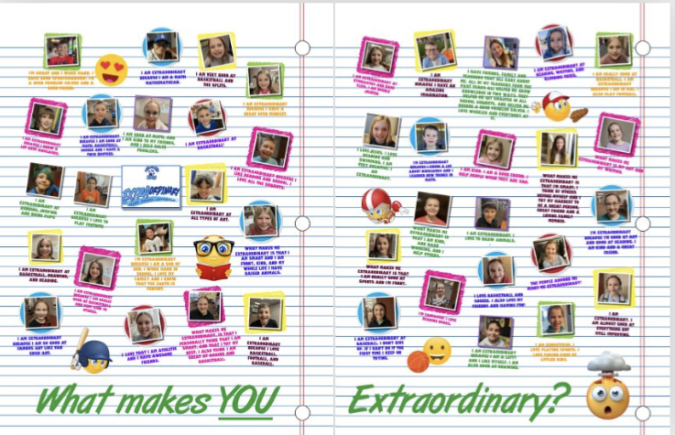Most popular
Subscribe to our blog
Most recent

Winners of the 2023 custom pages contest
As a new tradition initiated in the 2021-2022 school year, Treering's custom pages contest gave parents an opportunity to share the designs they create for their children's yearbooks. After narrowing nearly 500 submissions down to just 10, we took the vote to Treering's official Facebook and Instagram pages. The finalists earned thumbs up and hearts, respectively, while providing custom page ideas and inspiration to other parents. All ten finalists earned $50 from Amazon. The grand prize winner earned an additional $500 Amazon gift card.
On behalf of the judges and marketing department, we are thankful for each submission.
Grand Prize Winner: Lisa Ward From Keene, TX
It all began when her children asked for their extended family, who live across the US, to be in their yearbook. "We had a lot of fun reaching out to family to put together these pages," Ward said. "From California to North Carolina, Michigan to Texas, we like the reminder that family is forever!"
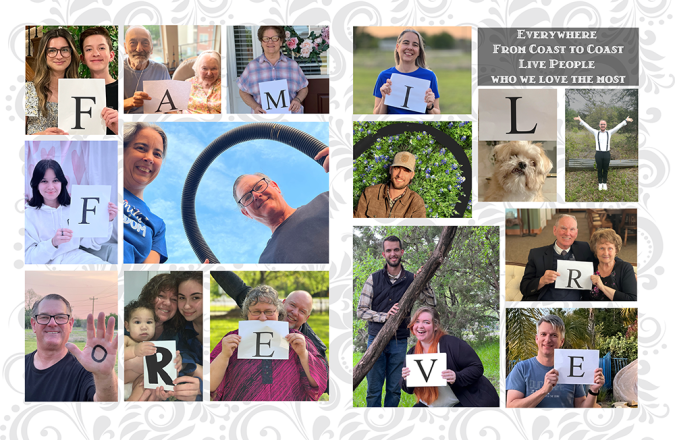
Why We Loved It
The core value of Treering's custom pages is for each family to make their child's book their own. Ward did that by involving her family. The coordination itself is award-worthy, not to mention the clever use of objects to center their "family forever" message with a heart.
Second Place Winner: Mary Frazee From Galt, CA
Frazee created a "Road Map" for her daughter's sixth-grade yearbook. "The pages feature all the fun things she learned and enjoyed along the way," she said. "I wanted to capture how much she has grown, and feature her first day of school photos for each year."
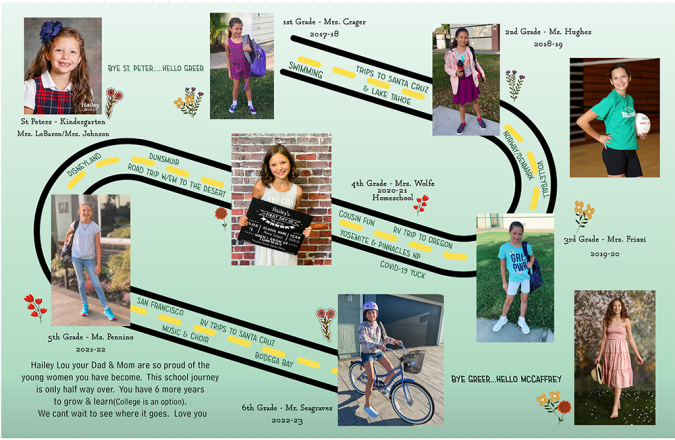
Why We Loved It
This is how you culminate an elementary school journey! The path from first through sixth grade showed all of Hailey's trips, achievements, and activities, as well as her teachers' names (the teachers on the judging panel felt seen). Using flowers to denote growth along the way, Frazee's design gives us a glimmer of the support and love in her home.
Third Place Winner: Sokunthea Mau From San Jose, CA
Mau wrote this to accompany her submission:
The media portrays high school as the peak of an American teenager's life. Can you blame them? The extravagant dresses at prom, the freedom teenagers have, the cap toss at graduation… As I went into my junior year of high school, I walked in with the mindset of every other try-hard Bay Area student: don’t mess it up. Junior year is coveted as being the most stressful time for a high schooler, due to the weight college admission officers put on this year. I overloaded myself with extracurriculars and difficult classes disregarding if I could manage everything all at once; in turn, my mental health plummeted and I faced burnout numerous times.
In spite of my struggles, I found myself crawling back to my comfort movies. The iconic opening scene in the Lizzie Mcguire Movie as she dances in her room replays in my head. What was it in these movies that made high school so appealing? The memories.
As I made this spread, I tried to envision myself as a stereotypical teenager gluing cutouts of my best friends on my page and listening to radio pop songs. I wanted to show what I wanted to reflect on when I remind myself of junior year, not the tests I failed or the classes I cried about, but the memories that kept me going. Like every movie coming to its resolution, my junior year has begun to tie up its loose ends, preparing for the credits and the uplifting background music.

Why We Loved It
As if Mau's verbal story wasn't enough, the application of her strategy won us. (Full disclosure: many of the judges lived through the days when you physically cut out and glued photos for yearbook pages.) Using her custom pages as a catalyst to bring joy back into her junior year, she also brought that positivity into ours.
"I love the many layers this spread has to offer," one judge said, "The texture of the fabric across the page adds even more depth into the junior year through the eyes of Mau. These little touches, I think, round this spread out and complete it."
Within her two pages, she told her story her way.
Meredith Lanning From Katy, TX
Lanning used her son Zach's pages to add additional band coverage to his yearbook "from marching season, competition show, dances, and best of all the Spring trip to Hawaii," she said. (This is just one of the eight she created.)
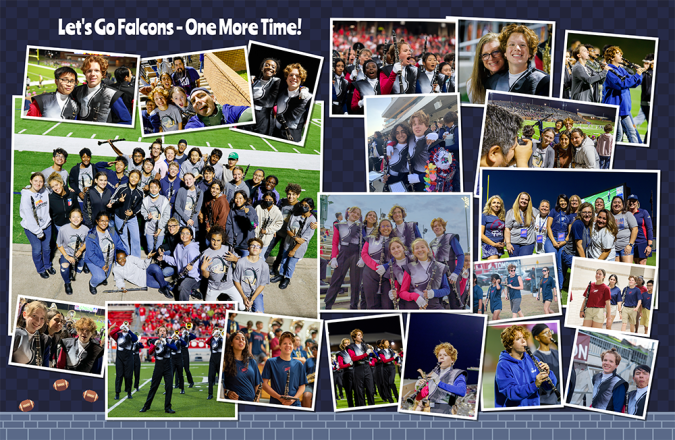
Why We Loved It
Lanning's behind-the-scenes look at her son's marching band shows the camaraderie and effort that goes into producing halftime shows. She anchored the spread with a large photo (we have a thing for variety) and repeated the white border to bring order. While the headline says, "One more time," we know they will relive these moments for years to come.
Finalist: Adriana Moya From Rahway, NJ
Nostalgia is always an emotion inducer. Moya set out to create a comprehensive look at her daughter's years from pre-K through 6th grade. "She has tried so many things that I wanted to remind her that she could choose any career that she wants," she said.
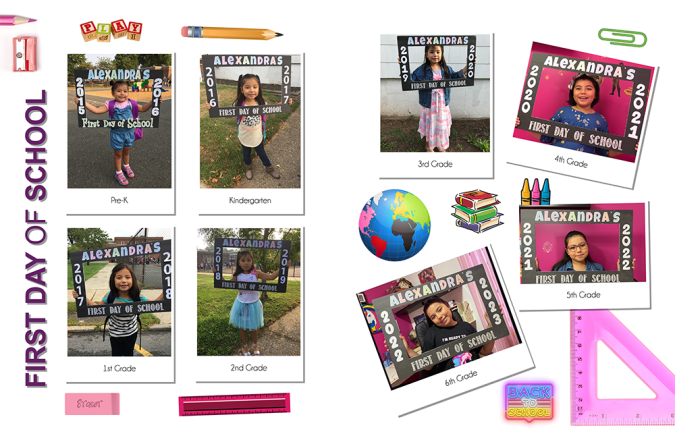
Why We Loved It
First of all, kudos to Ms. Moya for keeping the frame year after year. "That in itself is worthy of an award," one judge said. "I love the timeline," said another. The parents on the panel enjoyed seeing Alexandra grow, and the designers called out the consistent use of the caption block. It's clean and emotive.
Finalist: Jenny Errante From Phoenix, AZ
Errantes two daughters perform in their home state and beyond. She created a set of custom pages for each to call out their unique talents (for the sake of the contest, we chose older sister Evie's). "Both the colors and smokey overlay are representative of a stage atmosphere with a spotlight," Errante said.
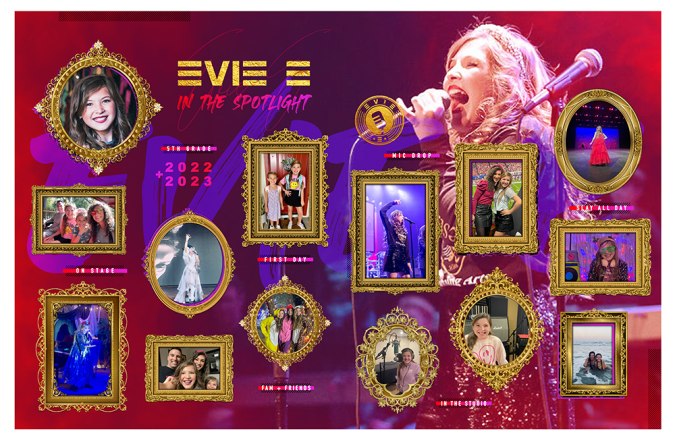
Why We Loved It
From color grading on the main image and the shaded Evie across the photo to the action shots within the gilded frames, this made our designers giddy with detail. "I love the background," one judge said. Each image supported the "spotlight" concept and Errante's daughter's love for the arts. (We're thinking creativity runs in the family.)
Finalist: Brooke Turner From Justin, Texas
Because her daughter loves bright colors, Turner created this kindergarten highlight spread with that in mind.

Why We Loved It
One of our judges said, "It's a kindergarten girl's dream." Turner's use of color and modification of Treering's About Me templates demonstrate an understanding of design theory. She kept to a softer palette and used the watercolor texture from a variety of Treering's themes to create this spread.
Finalist: Elyce Shorb From San Diego, CA
As a long-time Treering parent (these are her seventh set of custom pages), Shorb said custom pages "help my daughters share with their peers many activities and events that may otherwise have gone unnoticed." She uses them to highlight the twins' "personal highlights that showcase their extracurricular activities each year that include birthday celebrations, sports, Halloween costumes, field trips, school dances, and even family vacations."
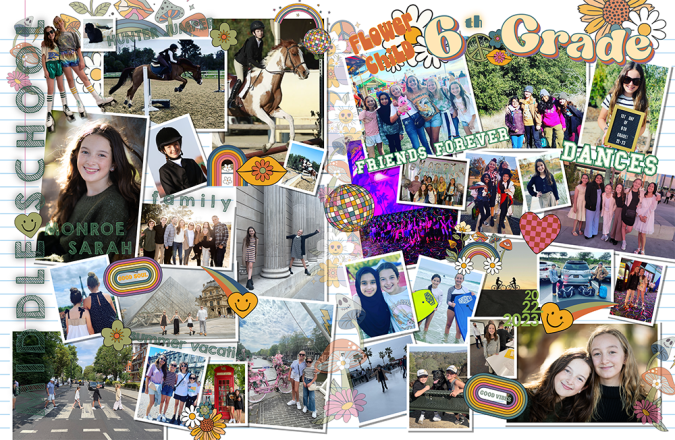

Why We Loved Them
Initially, we did a double take. Of all the parents who submitted multiple spreads, we decided to place both in the finals because Shorb honored her twin daughters with their individual interests and achievements using the same layout. And when we took a second look, we noticed the minor changes in the graphics: orange vs. pink heart, green vs. blue text overlay, etc.
"These two spreads remind me of what a girl at their age might have hanging up on their bedroom wall, photos of memories pinned up with pushpins or taped around the outer edge of a mirror," a judge said. "It brought a little nostalgia to my mind."
Finalist: Bhavika Lodhia From Aliso Viejo, CA
"We wanted to express his creativity, show off his dancing, acting, and athletic skills, and display his kindness and love towards families, friends and animals," said Lodhia.
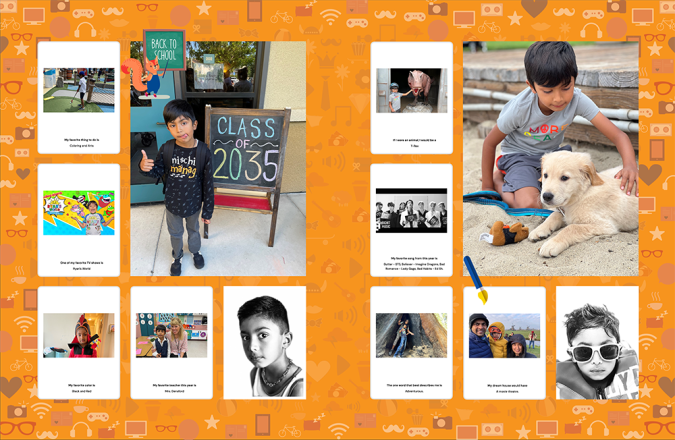
Why We Loved It
Using a combination of Treering memories and photos, Lodhia captured a moment in time by giving her son literal snapshots into his personal history and interests. We're hoping Lodhia re-creates the dog pic for comparison in a few years.
Finalist: Ashley Diamond From Moses Lake, WA
First grade was a pivotal year for Ollie. Diamond said, "He broke out of his shell and made some wonderful friends and even joined a few sports teams."
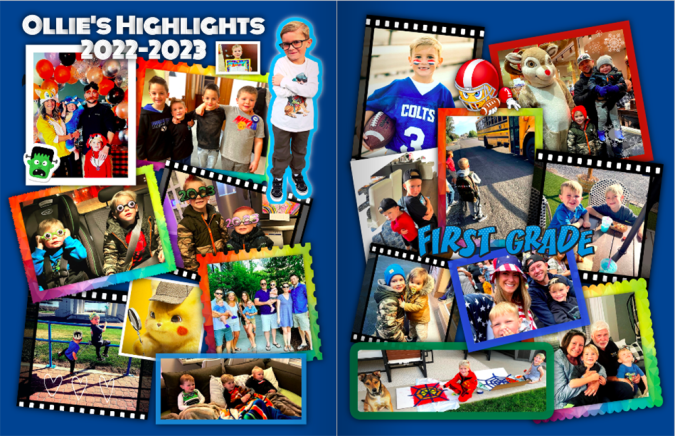
Why We Loved It
As you saw from our design contest, scrapbook-style design is trending. We love the frames, and while the rainbow ombre could get out of hand, Diamond balanced it with the film strip and solid color frames. This is truly a collection of highlights in Ollie's year.

Winners of the 2023 editor's choice design contest
For three years now, the Treering Design Contest is a spring tradition: advisers and student editors across the US and Canada enter their favorite spreads of the year. This time, we took the vote to the people: after selecting ten finalists from over 300 entries, the world shared the love and likes via the official Treering Facebook and Instagram pages. All ten finalists earned three free yearbooks and $50 from Amazon. The grand prize winner earned 10 free yearbooks and a $500 Amazon gift card.
"It is amazing to see the passion our editors have and inspiring to know we provide a platform for them to capture and share their memories."
Bobby Hernandez, Treering Head of Growth
On behalf of the judges—a team of editors, publishing professionals, graphic designers, and moms—who appreciate every person who submitted their stories and spreads, thank you for providing inspiration.

Grand Prize Winner: PACHEK, Hopkinsville, KY
Celebrating the 30th anniversary of their western Kentucky homeschool support group's formation, PACHEK used "photos from previous years related to [each section], along with a paragraph with a little bit of group history," parent and yearbook volunteer Lora Farrell said.
Why It's a Winner
Using Treering's "Groovy" theme, PACHEK captured the past and present. There is an obvious hierarchy with the headlines and graphics. We loved that every photo includes an identifying caption. One judge said, "This spread shows how easy it is to use Treering graphics and layouts. You can still edit them to make them personable to your audience."

2nd Place Winner: Harlingen High School, Harlingen, TX
Because songs are a tool and reflect moments in time, the team at Harlingen High School used song titles to shape and guide headlines and subheadlines. "They want the students to flip through the yearbook and be able to read but at the same time experience songs that will remind them of the good moments today which become the memories of our past that we will share in the future," adviser Zeila Rodriguez said.
Why It's a Winner
Beyond the music (see what we did there?), visually this spread oozes memories. It is laid out much like someone would save clipping and highlights on a corkboard. "[The hierarchy] draws the reader in," a judge said, "There is the main photo and you are able to easily follow the flow of the spread." Every photo tells a story and has an expanded caption to teach us what we didn't see. Another judge said, "You can almost feel the music as you read through the stories on this spread."

Third Place Winner: Jackson Tong, Evergreen Valley High School, San Jose, CA
When you hear all that Evergreen Valley High School does for its fall homecoming jamboree, it could be overwhelming. "During this season, student leaders create and host a large night rally show with numerous club and class performances, spirit days, dances, and athletic activities," student editor Jackon Tong said. They use multiple spreads to cover the week inspired by classic board games.
Why It's a Winner
Tong said, "Many students from all social backgrounds come together to celebrate our school spirit," and we loved that this spread highlights the diverse activities and groups involved with homecoming. The 24 photos are organized and we applaud the use of color to group elements visually. One of the judges said, "They did a fantastic job representing the lower classman at their school."
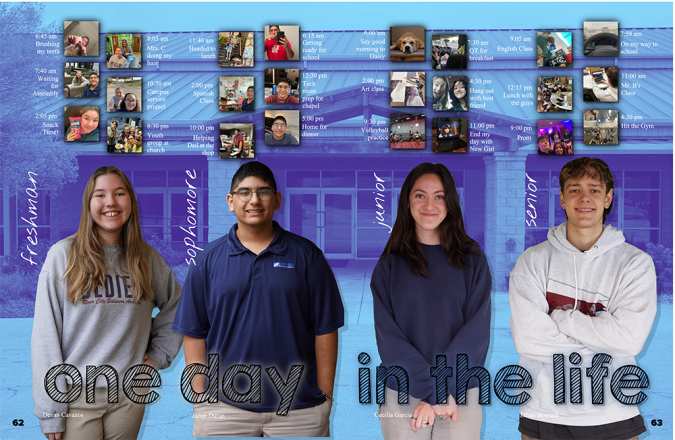
Finalist: River City Believers Academy, Selma, TX
Authenticity is the goal of the team at River City Believers Academy. Throughout the book, they wanted to showcase how they "do 'real life'" on campus and off. As a K-12 private, church school, they actively seek new enrollments and use the yearbook to help. "When people stop by the office they always like to look through our books, as they are a great indicator of the culture, love, and commitment we have for our school," adviser Carmen Garcia said.
Why It's a Winner
This is a well-executed idea to cover four more students in the book. We loved the combination of user-submitted snapshots up top with professional portraits. It shows how everyone has a story to tell. This spread could be replicated as a module on a portrait page or expanded to be a theme covering athletes, artists, administration, and academics.

Finalist: East Stroudsburg High School North, Dingmans Ferry, PA
Despite being what adviser Keisha Agard-Thomassine calls a "quirky bunch of souls who meet atop one of the beautiful Pocono Mountains in northeast Pennsylvania," the Timberwolf spirit is evident across each spread in the East Stroudsburg High School North yearbook. "We are brimming with talent and pride and our Carolina blue flickers through our halls, walls, sneakers, and Crocs," Agard-Thomassine said.
Why It's a Winner
From the color grading of the photos to the field hockey stick and ball frames in which the collages sit, this is exquisite. The judges also called out the lowered visibility of the background image as a tool to make the photos pop. The photos demonstrate intensity and action and the large cut-out looks to the right-facing page, directing the eye flow.
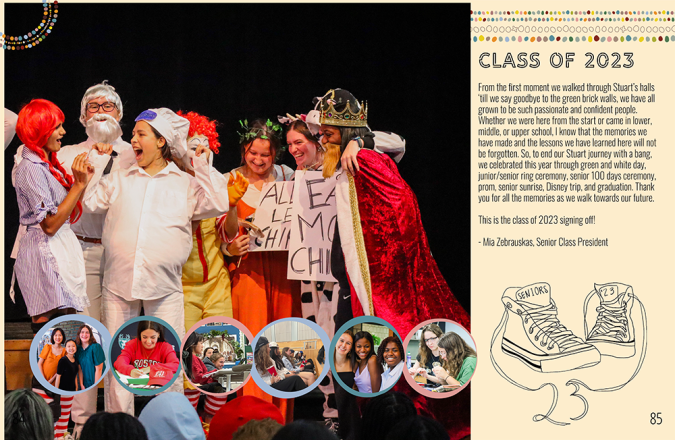
Finalist: Stuart Country Day School, Princeton, NJ
"Shoes tell a story," student editor Lucy Simon said. She and her co-editor have attended K-12 Stuart Country Day School for most of their lives. "A person's shoes are a unique expression of their journey and personality." The shoe motif and vibrant colors express the energy and excitement of the journey.
Why It's a Winner
When this spread came up in judging it was a hold-your-breath moment. The general intake of air preceded an enthusiastic discussion of the balance of the design and boldness of color. "I love the shoe graphic added on this page," said one judge after reading their story.

Finalist: Argo Community High School, Summit, IL
The sub-headline says, "Making it Memorable" and the team at Argo did just that. Traditionally, they've used a school color palette. "While we do have elements of the traditional maroon, we choose a wider palette to make this year different," adviser Lisa Garrett said. This diversion further strengthens their 2022-2023 yearbook theme, "Make Your Moment." Garrett said, "When you chose to collaborate, excel, succeed, and participate you are making memorable moments."
Why It's a Winner
Homecoming is one of those events that is larger than life on a high school campus. This spread captured what a treat it was for their school to have a week where their spirit went beyond the school walls (and pages). "This spread encompasses the meaning of school spirit and having community support," a judge said. Another said, she "loved use of the gumball machine."
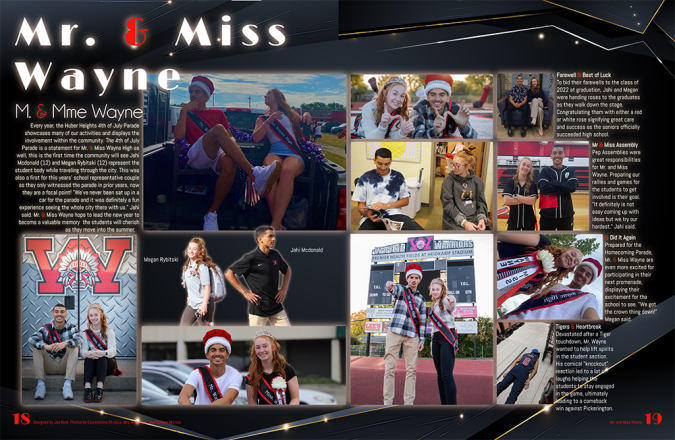
Finalist: Wayne High School, Huber Heights, OH
At the end of their junior year, Wayne students select two of their own to be community ambassadors for the school. Using a movie theme for the school's 75th anniversary of yearbook creation, each spread has cinematic flair. "One of our editors created this spread, and we love the little touches like the red [ampersand] throughout," adviser Beth Stacy said. "His inspiration was the movie 'Mr. and Mrs. Smith.'"
Why It's a Winner
We agree with Stacy: the pop of color is a small detail with a large impact on the design. This spread has balance in terms of copy, photos, and graphic elements. "The story behind this spread is fantastic. They did a great job using Treering's design features to tell the story with these photos," the judges said.
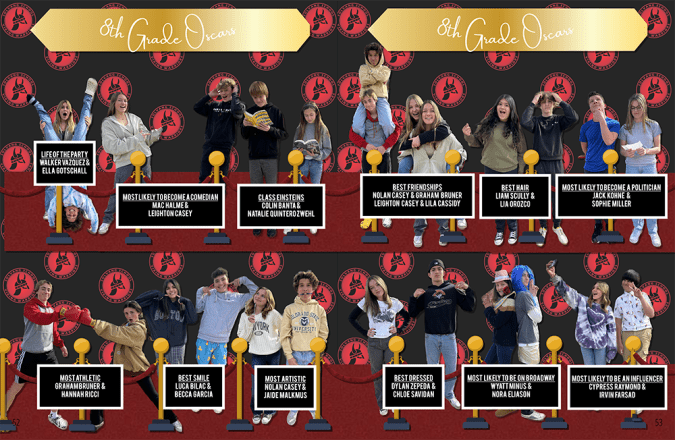
Finalist: Solvang School, Solvang, CA
Because the yearbook team used Treering's "Watching" theme, they "created a red carpet-style spread for our 8th-grade superlatives," adviser Alyssa Spanier said.
Why It's a Winner
The designers on the judging panel deemed the maximalism of this spread to be a show-stopper. It captured both the school spirit with the tiled mascot as well as the theme. What an energetic send-off for these students to high school.
"You have to enjoy the school spirit shown here," one judge said.
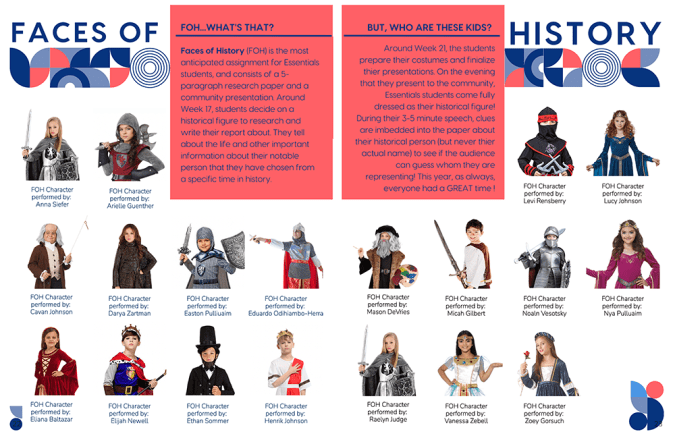
Finalist: Classical Conversations - South Bend Campus, South Bend, IN
"This design was inspired by one of my favorite design styles: Mid-Century Modern/Bauhaus," parent editor Carolyn Baltazar said. "I love how impactful and bold it is while still remaining very true to its extremely simple elements."
Why It's a Winner
Since over 1200 Classical Conversations communities publish yearbooks with Treering annually, this is one spread that can easily be replicated in each book.
Runners Up
If the top 10 weren't enough yearbook inspiration, check out this gallery of runners-up from Academy of Innovation, Central Middle School, Northern High School, Northampton High School, McKinley Steam Academy, Rawlins High School, and Wheeler Elementary School.
Honorable Mentions
Actis Jr. High
Baumholder Middle High School
Berean Academy
Cal Aero Elementary Yearbook
Camp Wekeela
Changemaker High School
Chapel Hill Christian Academy
Classical Conversations - Central Lakeland, FL
Classical Conversations - Dallas, TX
Classical Conversations - Greensboro, NC
Community Baptist Christian School
Council Jr./Sr. High School
Creative Learning Christian School
Dalhart High School
Deep Waters Academy
Doherty Memorial High School
Dumas High School
Eagle Ridge School District #36
Early College Academy High School
Founders Classical Academy of Flower Mound
Fox Meadow
Franklin Elementary
Freedom High School
Fulton Science Academy
George F. Baker High School
Glennallen High School
Grandview Hills Elementary
Haines Borough School District
Harrison Lane Elementary
Henderson International School
Hermosa Middle School
Hazel Point Intermediate
Heron Heights Elementary School
Lakeside Christian School
Landmarkhs.org
The Learning Connection Co-op
Lennox Middle School
Lois Lenski Elementary
Magnolia Science Academy Santa Ana
Mark Twain Elementary School
Mary Blount Elementary
MaST II Community Charter (Tacony Campus)
Mt. Eden High School
North Elementary School
Niles McKinley High School
Oakville MS/HS
Ocean Shore School
Orangeburg Christian Academy
Pelham High School
Phoebe School of Presidency
Piper School
Prairie Lea School
Queen's Grant High School
Radcliff Elementary
La Reina High School
Rita Ledesma Elementary School
Roaring Brook School
Sacred Heart Catholic School
Seabrook Elementary School
SEED School of Miami
Springton Manor Elementary School
Sycamore Creek Elementary
Tech High School
West Valley High School
WR Odell Elementary

Yearbook hero Box Max collaborates and listens
Treering Yearbook Heroes is a monthly feature focusing on yearbook tips and tricks.
Single-handedly holding down the office during the pandemic, Treering engineer Box Max is one of the most senior members of the engineering team. In honor of his fifth anniversary, we wanted to celebrate how he improves the yearbook creation process on the back end.

His teammates say he is the perfect collaborator during the debugging process because his listening skills help other engineers work through their problems. They explain the code, line by line, to Box Max and therein discover snafus. He doesn’t pass judgment, just attends.
Serving as the voice of restraint, he doesn’t commit to action quickly or make rash code decisions (which the support team appreciates). It’s this consistency and reliability that make him an exemplary employee.
He’s also trusted with trade secrets as Treering builds and improves our robust design platform that serves both technical and emerging designers. Tight-lipped, Box Max is trustworthy and the perfect person to hold Treering’s secrets.
Happy April Fool’s Day from your friends at Treering!
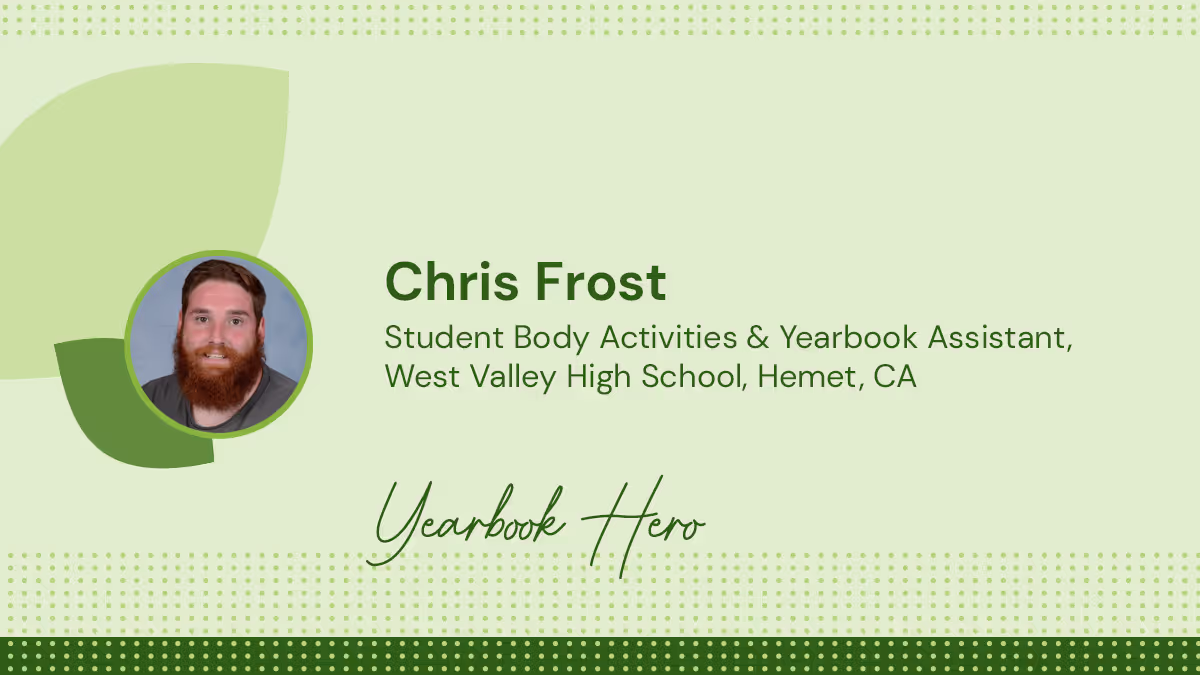
Yearbook Hero Chris Frost’s multisensory approach to memory keeping
Treering Yearbook Heroes is a monthly feature focusing on yearbook tips and tricks.
As a student 17 years ago, Chris Frost helped West Valley High School transition from orange cropping pencils to InDesign. He spent three years on the yearbook staff, and in his senior year became Editor in Chief. After working for guest relations at Disneyland, he returned to the Inland Empire as a SPED aid and moved into the activities assistant role he currently holds, splitting his time between ASB and yearbook.

Tell me how your students are creating more than just a visual book this year.
It started with an idea, really. They wanted to create a Spotify-themed yearbook and it was a reality instantly because Treering has the Wrapped theme.
It’s all about the music: on sports spreads, we have codes for athletes’ amp songs and instead of doing senior quotes, we are doing senior songs. Being able to capture a moment in a song connects those dots you don’t remember, such as the song the homecoming king and queen danced to. We are capturing that moment, so in 10, 20, 30 years students can really flashback. That’s the point of a yearbook.

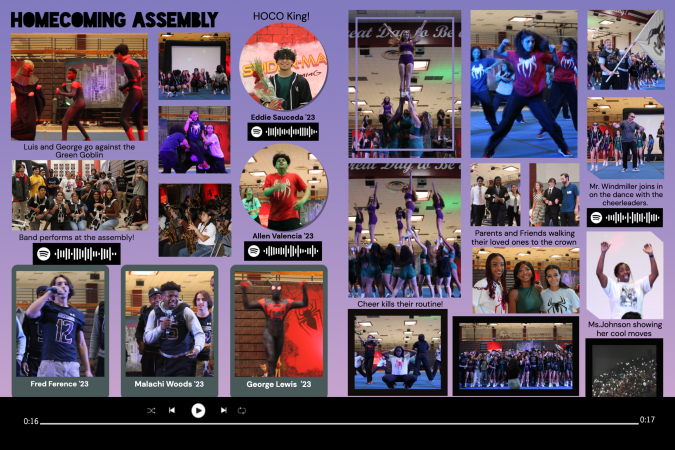
Were you worried about some of the song submissions?
The team gave students parameters ahead of time. Since this is a school-published book, the standard requirement is it has to be appropriate without any foul language (radio edits only). Because it’s also a student publication, we want to maintain students’ freedom of expression.
What does your design process look like?
Our students are very independent: for example, last year, we used the Not a Diary theme and a graphic artist on campus created hand-drawn doodles throughout the yearbook. This theme resonated with students because of the nostalgia and emotion. It was healing after returning to campus from the shutdown.

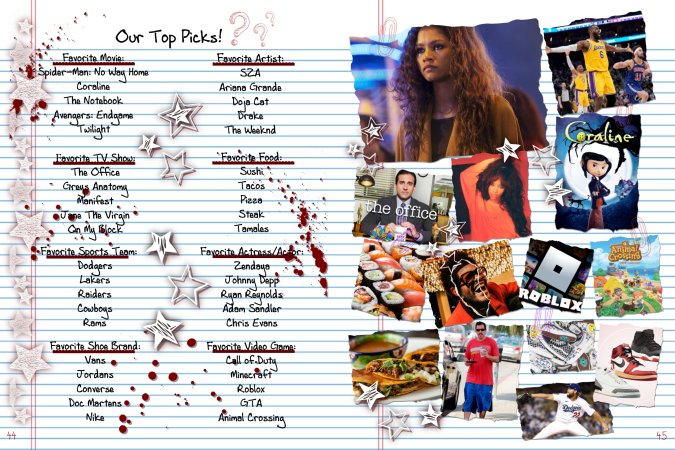
The thing Billy [Valenzuela, yearbook adviser] and I enjoy about Treering’s software is you can use bits and pieces of the design library or use 100% pre-done. We are able to scaffold based on the individual yearbook students’ needs.
What other methods do you use for storytelling?
Treering’s custom pages give our students more ownership and control of their yearbook, and because we can review them before they go to print, it gave us the ease we weren’t going to randomly publish something sketchy. Some of the creativity that goes into yearbook production is passed on to students outside of the yearbook program.
How else does Treering help?
The biggest benefit to West Valley is we produce great yearbooks at a cost our kids can afford. We don’t have to increase the cost of the yearbook, and because of Treering, our book is $20-25 below other schools in the area, making it more accessible.
Yearbook is essentially carrying on and documenting the history of the school. The enormity of that task is what motivates our students. It’s important to create something that speaks to all students, not just one grade or one class.
West Valley was with another yearbook company for 30 years. Change became necessary when we could no longer pass on savings to our students. We would pre-sell 300-400 yearbooks and still be charged for overruns. We were storing books it cost $60-70 to produce despite selling ads and fundraising to meet the contract terms.
The relationship no longer benefited our school or the students.
When we couldn’t host a year-end pizza party for the yearbook team because there is $20 in the activities fund and a $2000 final bill, we said, “This isn’t working for us.”
It’s freeing now to have no order minimums and worries about over-shipments.
What advice would you give to someone just getting started as a yearbook adviser?
Let them struggle a little. This is one of the hardest lessons that I think we as advisers have to learn. Often we have the urge to swoop in and support our students when they start to get frustrated. This robs them of growth opportunities. Of course guide and suggest, but let them do the hard work of getting to the answer. Ultimately it will set them up for success in the future.
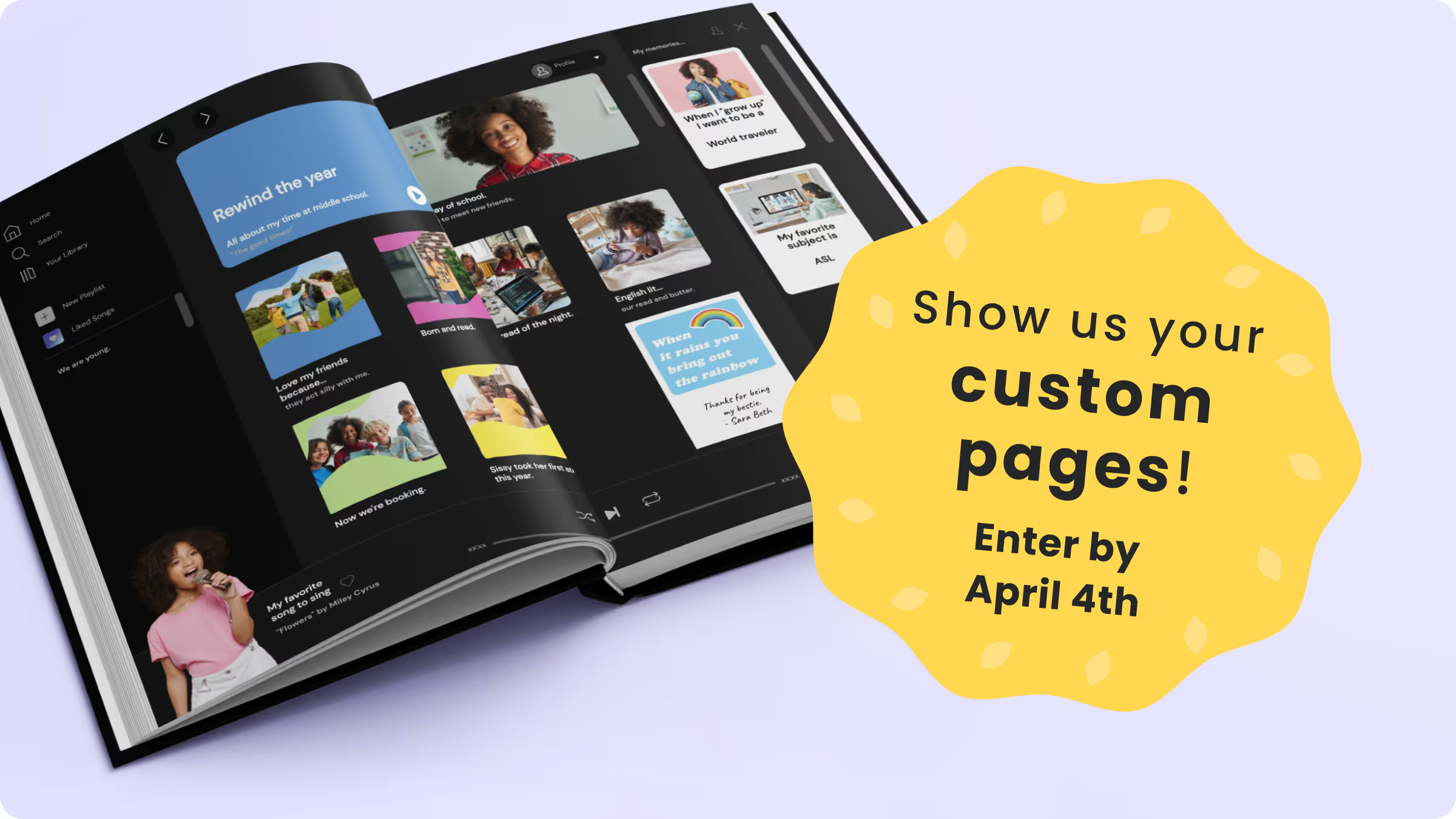
People's choice custom pages design contest official rules
Official Participation Rules and Steps to Enter:
- You must be at least 18 years old and a parent, faculty/staff member, or student at a Treering school to participate.
- To participate, fill out the submission form and include a screenshot of your child’s 22-23 yearbook custom pages and also a short paragraph (250 words max) about your design. Double-check everything for accuracy, especially your email and phone number (this is how winners will be notified and prizes will be distributed) and your school name and address (city and state only are acceptable). Incomplete entries will not be accepted.
- Share your spread on social media via: Facebook and/or Instagram (post on both, and get an automatic extra vote!)
- Submit the post using your personal Facebook/Instagram account or your school’s Facebook/Instagram account.
- Include the screenshot of our personal pages in your post.
- Tag @treering (Facebook) or @treeringcorp (Instagram) in your post.
- Use the hashtag #treeringmemorymaker in your post.
- Ensure your post is shared publicly so we can see it and include your submission.
- Submissions are due by Tuesday, April 4th, 2023 by 8 PM PT.
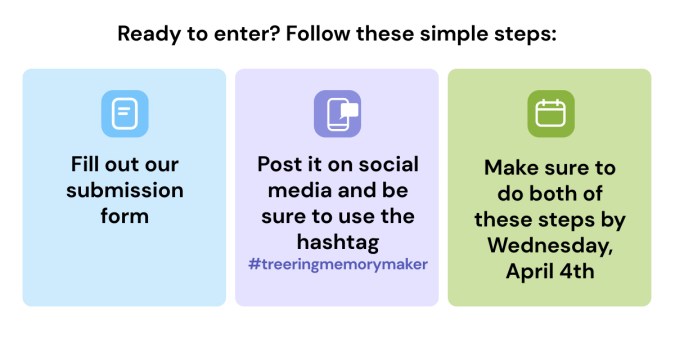
Judging and Finalist Selection
Ten finalists will be posted on our Facebook and Instagram pages by 12pm ET on Thursday, April 6th. Finalists will be chosen based on the entered custom page design and storytelling ability. A panel of Treering yearbook professionals, graphic designers, parents, and journalism educators will select the finalists. Each finalist’s work will be posted on our Facebook and Instagram pages and the submission with the most combined Likes/Hearts will win the grand prize.

After voting, the winner will be notified via email and phone on Monday, April 10th. The Amazon gift cards will be sent electronically to the email provided in the form. There will be ten finalists and one grand prize winner.
Editors’ Choice Awards Prizes
The 10 finalists will each receive one $50 Amazon gift card. The Grand Prize Winner will receive one $500 Amazon gift card and a future profile on our Treering blog. The gift cards will be sent electronically to the email provided in the form.

Ownership
By submitting your custom pages, you have verified the approval of others pictured, and you approve Treering to use your name, write-up, and school name for any marketing purposes, including but not limited to showcasing on www.treering.com, sharing on social media, and sharing with media.
Enjoy yourself! We can’t wait to see your stories. If you have any questions, contact us at marketing@treering.com.
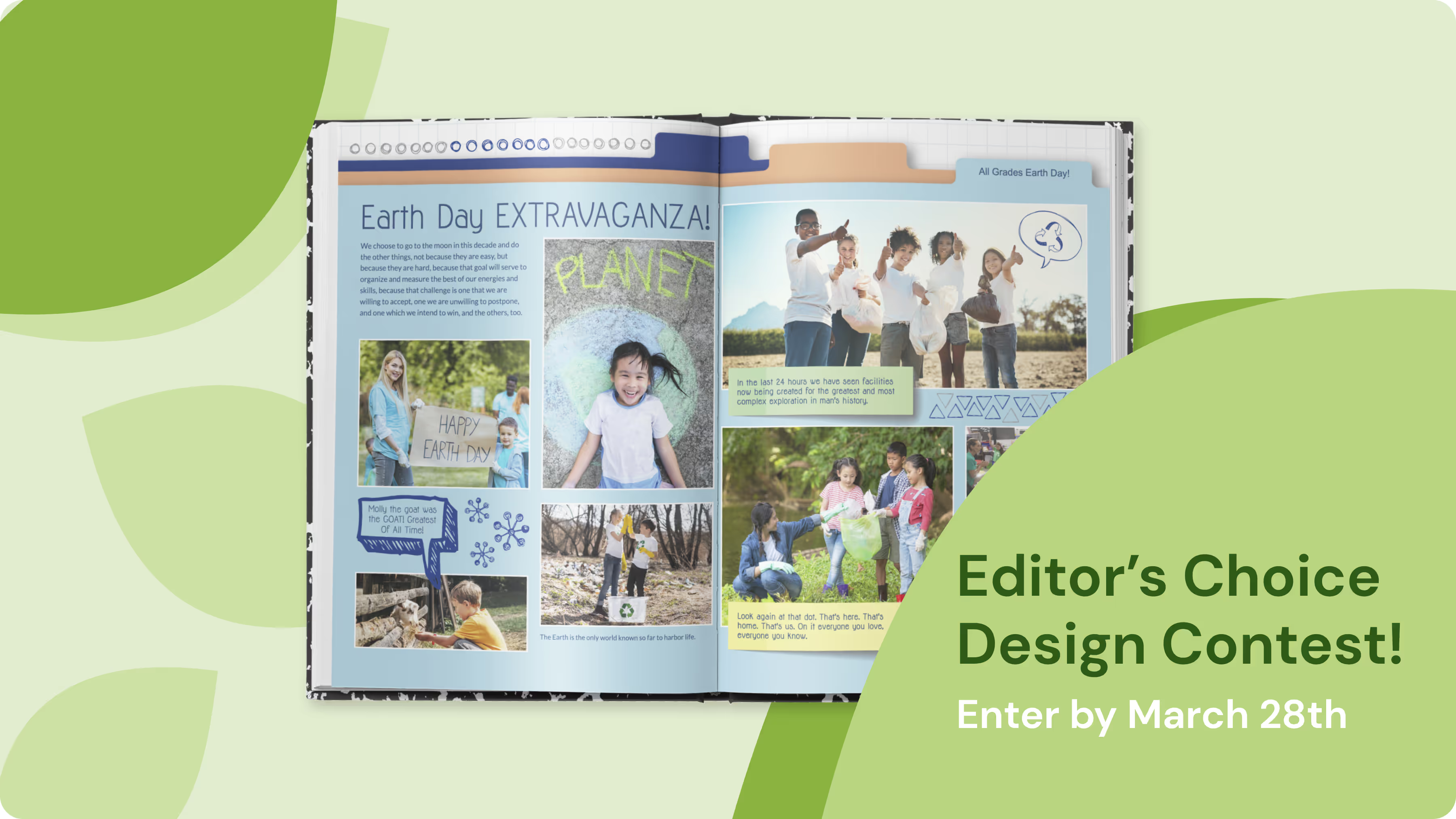
Editors' choice design contest official rules
Update 3/30: Vote for your favorite finalist on the official Treering Facebook and Instagram pages.
Official Participation Rules and Steps to Enter:
- You must be at least 18 years old and a parent, faculty/staff member, or student at a Treering school to participate.
- To participate, fill out the submission form and include a screenshot of your favorite 22-23 yearbook spread and also a short paragraph (250 words max) about your school’s story. Double-check everything for accuracy, especially your email and phone number (this is how winners will be notified and prizes will be distributed) and your school name and address (city and state only are fine). Incomplete entries will not be accepted.
- Share your spread on social media via: Facebook and/or Instagram (post on both, and get an automatic extra vote!)
- Submit the post using your personal Facebook/Instagram account or your school’s Facebook/Instagram account.
- Include the screenshot of your yearbook spread in your post.
- Tag @Treering (Facebook) or @treeringcorp (Instagram) in your post.
- Use the hashtag #treeringwin in your post.
- Make sure this post is shared publicly so we can see it and include your submission.
- Submissions are due by Tuesday, March 28th, 2023 by 8 PM PT.
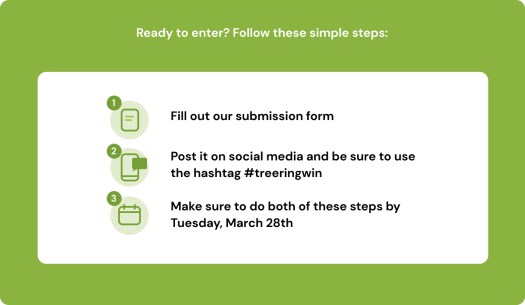
Judging and Finalist Selection
Ten finalists will be posted on both our Facebook and Instagram pages by 12pm ET on Thursday, March 30th. Finalists will be chosen based on the entered yearbook layout design (5 image maximum) and storytelling ability.
A panel of Treering yearbook professionals, graphic designers, parents, and journalism educators will select the 10 finalists. The finalists’ work will be posted on our Facebook and Instagram pages and the submission with the most Likes/Hearts on each page combined will win the grand prize.
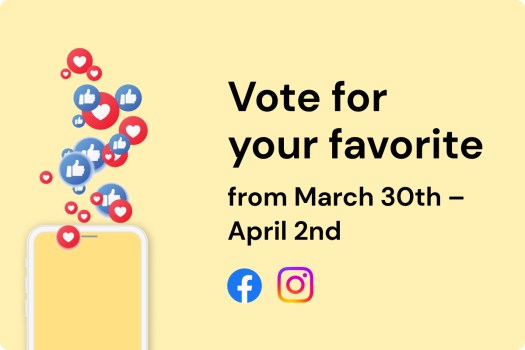
After social media voting, the Editor's Choice Grand Prize Winner will be posted on our social channels and notified via email and phone on Monday, April 3.
Editors' Choice Awards Prizes
The 10 finalists will each receive one $50 Amazon gift card and three free yearbooks. The Grand Prize Winner will receive one $500 Amazon gift card, 10 free yearbooks, and a future profile on our Treering blog. The gift cards will be sent electronically to the email provided in the form. Free book coupons will be loaded into the school's Treering Yearbook account and may be used in the 2022-2023 or 2023-2024 school year.
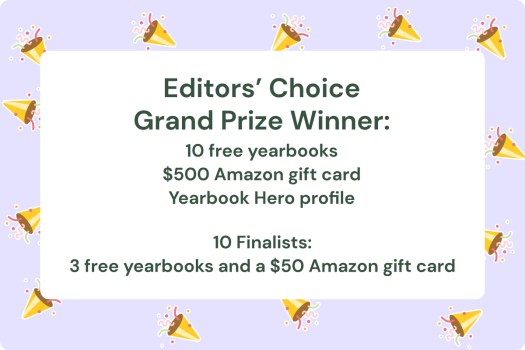
Ownership
By submitting your yearbook spread, you have verified the approval of others pictured, and you approve Treering to use your name, write-up, and school name for any marketing purposes, including but not limited to showcasing on www.treering.com, sharing on social media, and sharing with media. Enjoy yourself! We love this journey for you. If you have any questions, contact us at marketing@treering.com.

Yearbook hero Beth Stacy writes history
Treering Yearbook Heroes is a monthly feature focusing on yearbook tips and tricks.
Like many of us, Beth Stacy didn’t set out to be a yearbook adviser. As a special education teacher, she focused on reading intervention and built her reputation as a writing pro and Read 180 instructor. After moving from Florida to Ohio, her new principal asked her to co-teach the yearbook class because she wanted it to be more journalistic. The program was already under scrutiny: the district, concerned over a debt-burdened program, was ready to shut things down. In 2017, the team at Wayne High School moved to Treering, reducing the financial burden on the school and the stress of deadlines for the advisers.
Co-advising sounds like a dream. How do you make it work?
The business teacher and I share responsibilities. She and I split the class on Tuesdays and Thursdays. She focuses on visual skill development and marketing while I teach writing and interviewing.
During the first quarter, the four seniors lead teams. They divide the sports spreads and divvy up tasks. Within their teams, they choose how to break up tasks. For example, there are 92 band members and 32 Warriorette and they have to interview them all. That team assigned instrument groups to each team member (woodwinds, brass, etc.).
Second quarter, students determine if they want to work with a partner or solo for their next spread. As the year progresses, they grow more independent.
With a school of 1800, how do you ensure coverage?
We do a big book–250 pages. Also, we use the index report to identify students who are not in the book and brainstorm open-ended questions for student profiles inspired by Humans of New York. These Humans of Wayne profiles undergo a revision and editing process before going in the book and on the Signal’s Instagram.
Because we include prom, graduation, and our track team, from which members compete each June at the state finals and potentially at nationals, Wayne High School is a fall delivery school. For the first time, we are going to use Treering’s ship-to-home option so we don’t have to plan distribution during the summer for open house.
It’s the 75 anniversary this year for their yearbook–what are you doing to make it special?
My students are finding ways to link the past to the present. One of my editors created two spreads using the previous covers. We are missing ten years and working with the alumni association and hopefully the historical society to track them down.

The first yearbook has a write-up from the original editor. We will honor the previous teams who established and maintained the yearbook tradition as well as legacy athletes since we are a big sports school. Our head football coach is a first-generation Warrior and his son is a senior. Nearly two dozen members of the faculty are alumni and will appear with their senior yearbooks.
Teaching yearbook is such a different experience than being on staff as a student. I absolutely love it, but it is one of the most fun yet difficult classes I've ever taught!

Yearbook design hierarchy
Design hierarchy of a yearbook spread refers to the arrangement of elements on a page in order of importance, with the most important element drawing immediate attention and receiving support from secondary and tertiary elements. When you apply these design principles, you are taking your readers on a journey across each yearbook spread by telling them where to begin and where to exit each spread through visual cues. Sound complicated? No worries, we'll break it down below.

Dominant Elements
Think, "We're #1!" The dominant elements in yearbook hierarchy are headlines, the dominant photo package, and a subheadline. The dominant elements are just that: they dominate the most real estate on the spread. It's from them the rest of the content builds.
Headline
The headline is the most important element on a page and serves as a brief content summary. It should be attention-grabbing and provide an overview of the page's content.
Dominant Photo
This is self-explanatory: the largest photo on the spread is the dominant one. It draws the eye. It connects to the headline. It sets the tone for the entire spread. The best dominant photos are storytelling or action shots.
Subhead
The subhead is a secondary headline that provides more detail and context to the main headline. It can also be used to break up yearbook spreads into smaller sections, or modules.
Secondary Elements
Your secondary elements build from your dominant ones. Think of them as a great ensemble cast.
Photos
For most, photographs are the most important part of a yearbook. The individual images and their positioning on the spread can help further illustrate the page topic and make the page more visually appealing.
Quick tips:
- Eyes should look toward the center of the spread, not off the page
- Similar photos should be in proximity to one another
Tertiary Design Elements
If your headline and photographs did their job, readers will swoop in to enjoy your captions, copy, and extras.
Captions
These beauties provide context and information about the photos on a page, therefore they should be near their respective photograph. While they should be concise and well-written, it's easy to get cliche: "Tomás Bernal (7) enjoys his lunch." Start with the 5 Ws and then up your caption game by adding expanded captions.
Body Copy or Yearbook Stories
This is the main text on a page and provides the details and information about the subject being covered. It should be well-written, easy to read, and relevant to the headline and dominant topic of the spread. Often, when a dominant photo is of the storytelling variety, it will complement it and further explain its significance.
Sometimes, an "ident caption" will suffice. This is a list of names of students pictured, including their grade. In the middle school book below, the yearbook team used ident captions to outline the event program from the annual fundraiser.
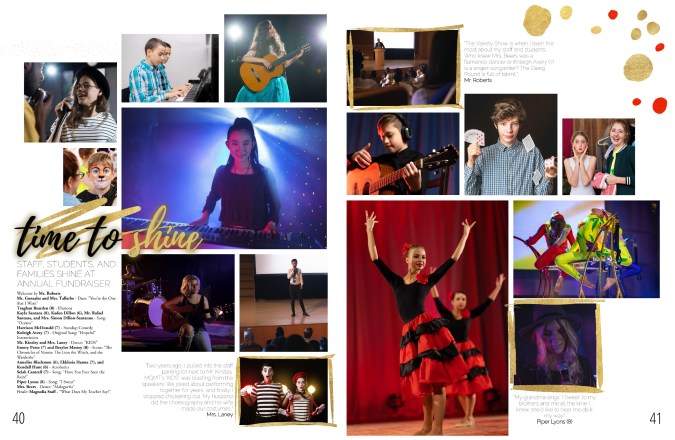
Pull Quotes
Pull quotes are quotes from the body copy that are set off visually and used to highlight important or interesting information or one-off quotes from a student. They have both visual and verbal significance because they highlight the spread's topic with a unique POV. They can also add to the overall theme by bringing in theme elements.
Graphics and Design Elements
Like everything in yearbook design hierarchy, graphics and design elements, such as borders, backgrounds, and page numbers should be intentional. It's easy to get out of hand with Treering's graphics library, so that's why our design team cultivated 300-ish fully editable themes and color palettes for you. The purpose is to make the page more visually appealing and easier to navigate while telling the story of your year.


The hierarchy of a yearbook spread can vary depending on the page's content, and following this basic structure can help ensure that the page is well-organized and easy to read. If you're teaching yearbook or leading a club, use it
- As a checklist for students who are beginning to design
- For a scavenger hunt to see who can identify elements on a spread in a magazine or another school's yearbook
- To build your program by strengthening yearbook hierarchy in each design

Yearbook myths
School-friendly is the descriptor that popped up in an email about yearbook companies. It made me snort. As great as my relationship with my sorority sister-turned-yearbook rep was, I no longer could reconcile the bottom line on the invoice, demands from school administration, and equity concerns for students. While it was time for a change, options seemed limited. Aren't all yearbook publishers the same? That myth and others nearly kept me (and many other advisers) from making a beneficial shift in the name of students. Let's go through the top six yearbook myths together and learn the truth.
Myth 1: Customer Service is a Thing of the Past
Treering re-wrote the traditional approach to yearbook contracts and customer service to meet the changing needs of parents and educators by leveraging the technology they already use in the classroom and workplace. Editors receive real-time help without having to leave school or pre-scheduling an appointment. Instead of having one person on which to depend, there is a team of experts to assist with account management, design, and ongoing training.
Beyond the live agents and customer success managers—most of whom are current or former yearbook advisers—Treering users take advantage of:
These tools improve knowledge sharing and provide their staff and students with more opportunities for development and growth.
Myth 2: I’m Not in the Yearbook
We all know students don’t purchase the yearbook because they are unsure if they will be in it, so we provide coverage tips to help you and your staff gather stories in fresh ways. Also, students who transfer schools mid-year can still be a part of it because yearbook editors can also add students to the portrait section at any time.
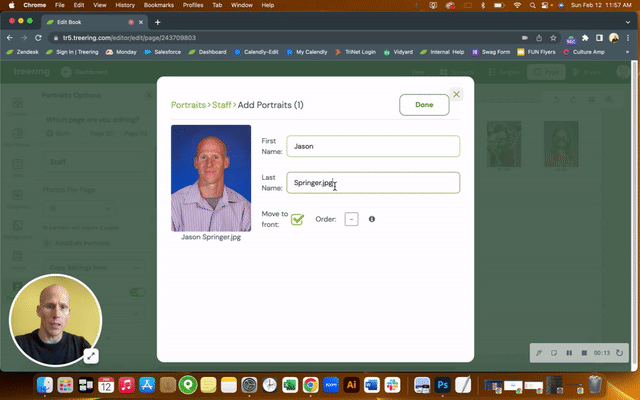
In addition, advisers can give students ownership of their memories: every Treering yearbook includes two free pages on which they can drop their vacation, extra-curricular, and milestone photos. (Even better? It’s less than a buck to add two more.)
Myth 3: You Can’t Include Spring Sports and Events in the Yearbook
Editors love being able to set their own deadlines and extend them if they need more time. That December 17 book order deadline is no more. With a guaranteed three-week turnaround, you have beyond February to complete your yearbook, ensuring time to capture lacrosse season, Read Across America Week, and other spring events.
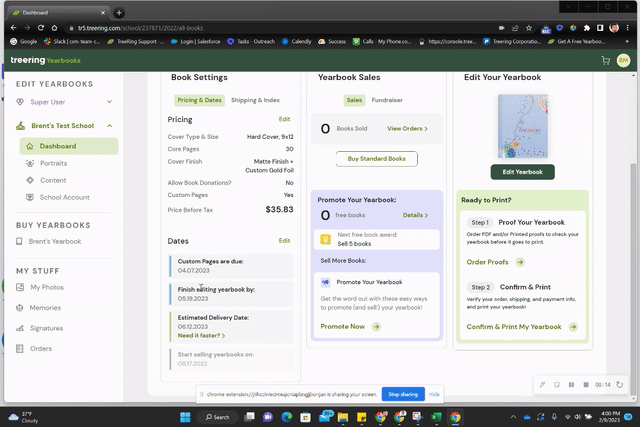
Ship to Home for Fall Delivery
Yearbook Hero Beth Stacy’s school traditionally does a fall delivery. Instead of strategizing distribution over her summer break, she uses Treering's ship-to-home feature so graduates, international students, and military families all receive their yearbooks.
Myth 4: Yearbooks Are Out of Date
In a digital world, it’s nice to have something tangible. Yearbook coordinator Erin McDonald prompts, “Are you going to hand your kid the Cloud when they graduate?”
Yearbooks are a testament to the events, people, and culture of a particular moment in time. They provide a historical account of what was happening in a school, community, or organization and allow us to relive the essence of our past. Because they serve as a showcase for individuals to display their talents and bask in their successes, yearbooks also offer an opportunity to celebrate the achievements and accomplishments of students, staff, and campus organizations
They show how each member contributes to the story of the whole.
Also, from a pedagogical perspective, yearbooks offer a canvas for students, staff, and volunteers to express their creativity through writing, photography, and design.
Myth 5: Numbers are Firm in Fall
It’s freeing to say, “Yes, you can still order a yearbook.”
Tweet
Treering advisers say they never have to say no to a student: if someone misses the school’s deadline, they may order a book to be shipped to home. Your school’s storefront is always open.
Myth 6: I Always Have Too Many Leftovers
Conversely, say goodbye to overruns and hustling boxes of old yearbooks at alumni events. Frankly, schools are financially punished for these and they are a waste of resources and space. Moving forward, every year is a sell-out year because your yearbook shipment only includes what was pre-sold. You can breathe deeply, knowing the pressure to make a sales quota is eliminated. The savings are passed on to families.
The misconceptions about yearbook publishing end here.

How to write yearbook headlines
Not only is it a part of the dominant element of your spread’s hierarchy, but headlines also help organize the yearbook by providing a visual cue and structure for the content. An effective headline can help a reader quickly understand the content of a page and decide if they want to read more. (They should!) When writing headlines for your yearbook, follow these five guidelines.
1. Set the Tone
The tone of your headlines should match the tone of the yearbook, whether it is lighthearted, serious, or something in between.
Many advisers begin the theme development process with an idiom dictionary nearby to create a lexicon for the year. By incorporating keywords and phrases from the yearbook theme into the headlines, designers create a consistent and cohesive story, which ultimately strengthens your theme.
Take a look at this example: with the Treering Theme Stay Gold in mind, the editorial staff looked at all the phrases using gold and built out a list. They then assigned potentials to spreads. Notice how gold is frequently used, as are synonyms such as shine and glitter.
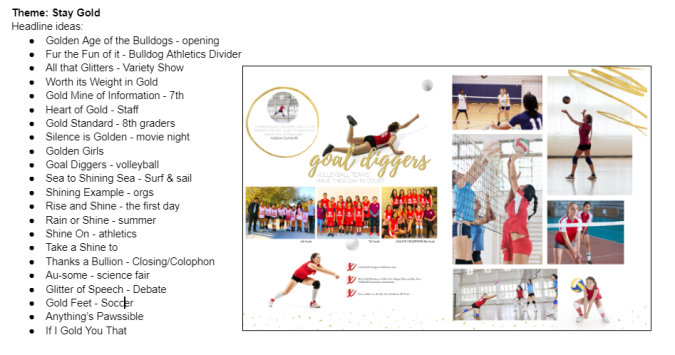
Considerations for Theme Copy in Yearbook Headlines
- Resist the urge to make every headline the same. In a book titled “Then & Now,” you can only have so many headlines with an ampersand. (Trust me, it was a first-year yearbook fail.)
- Use spin-offs to highlight the main concepts of the theme. Your headlines and subheadlines exist to bring the yearbook theme to life and make it an integral part of each story and spread.
2. Maximize Your Space
Focus your yearbook headlines and limit them to no more than a few words which accurately reflect the content of the story they introduce.
Advisers, here are some exercises that can help students produce stronger headlines:
Headline Critique
Have students work in groups to critique headlines written by their peers. Collaboratively, students learn to identify strong and weak yearbook headlines and develop a critical eye for headline writing.
News Scavenger Hunt
Collect headlines from various sources (some ideas are below in section five) and analyze them for clarity, conciseness, and relevance to the content. This exercise can help students understand the importance of writing headlines that accurately reflect the content and grab the reader's attention.
Headline Revision
To help students learn to refine their headline-writing skills and make their headlines more effective, have students write several headlines for a given story or event and then revise them to make them more concise, clear, and attention-grabbing.
3. Follow AP Style guidelines:
When it comes to all things style, the Associated Press Stylebook sets the rules for copy, abbreviations, and formatting.
- Capitalization: Capitalize the first word and all subsequent important words in the headline, including prepositions and conjunctions of four letters or more.
- Active voice: Use active voice in your headlines, as it makes them more dynamic and engaging.
- Punctuation: Limit the use of punctuation in headlines, typically using only a single exclamation point or a question mark, if necessary. (Personal anecdote: My undergrad journalism professor told me I get three exclamation points in my career, and to use them wisely.)
- Conciseness: Keep headlines concise and to the point, typically no more than a few words.
- Spelling and grammar: Make sure to check the spelling and grammar of each headline to ensure that it is error-free and professional-looking.
4. Wordplay Works
Make your English department swoon with literary techniques such as puns or alliteration if appropriate.
While "Football" is a straightforward and accurate way to describe the subject matter, using it as a headline for a story about the football team in a yearbook may not be the most engaging option. To make the headline stand out and capture the reader's attention, it's often better to use wordplay or a more descriptive phrase that goes beyond just the basic name of the subject.
For example, instead of simply using "Football" as the headline, you could use an alliteration that showcases your mascot such as “Lions on the Line” or "Touchdown Titans."
You could even use something from the story copy to tie the spread together: below this cheer spread's feature story is about the relationship between cheer flyers and bases.
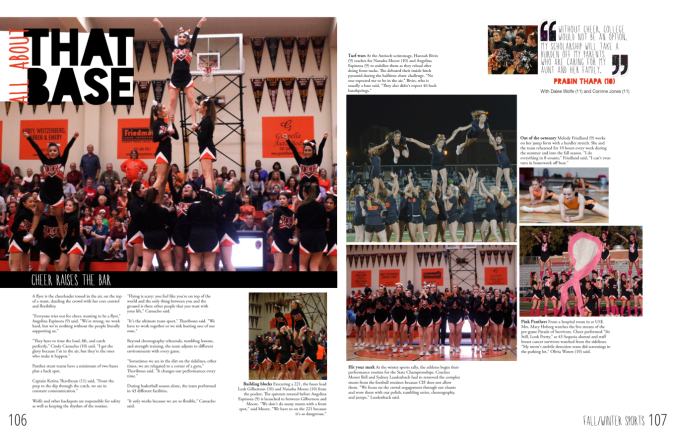
5. Keep Headlines Timely
Consider the current events and trends that are relevant to the yearbook and include them in your headlines. From Homecoming (Game of Thrones) to personality profiles of faculty (How I Met Your Teacher), you can get creative in the Heartland (any location on campus, such as the quad, where the whole school gathers). See what we did there?
Find inspiration by looking at
- News websites and magazines
- Social media platforms
- Advertisements
- Books and novels
- Popular songs, TV shows, and movie titles
- Quotes and (appropriate) jokes
- Previous yearbooks
Following these tips and finding your headline groove will strengthen your yearbook theme and tell the story of your year. For additional writing tips, check out these blogs:

Six ideas to fill pages
Page count can be a dirty word in the yearbook industry. It’s how we compare programs or evaluate pricing. It's also how we wow our readers. Peppering in showstopper spreads breaks up the monotony of photo collages, portraits, and team photos. These pages also fill your yearbook with even more personal stories and unique-to-this-year happenings. (And if we're being honest, these last-minute ideas can help you increase coverage with ease.)
1. Interactive Pages
Drop-in yearbook spreads, such as about me pages make it effortless to complete the year's story. You can customize the questions and prompts on these fully editable yearbook templates and give students even more space to share their POV on the year. If you don't have a spread to fill, consider adding a sidebar so students can react to campus happenings.
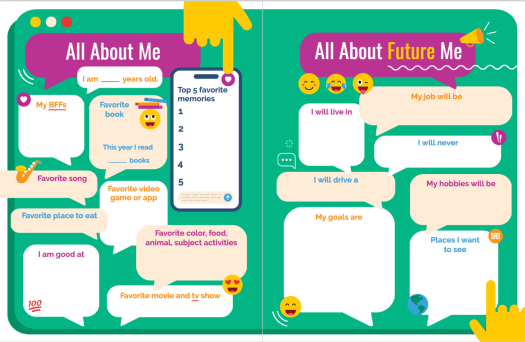
2. Spirit Quiz
When Sequoia High School had over half a page to fill in their junior section, they added a teen magazine-style quiz. This spirit self-assessment featured eight additional students plus the school mascot while showing off what is uniquely Panther programming.
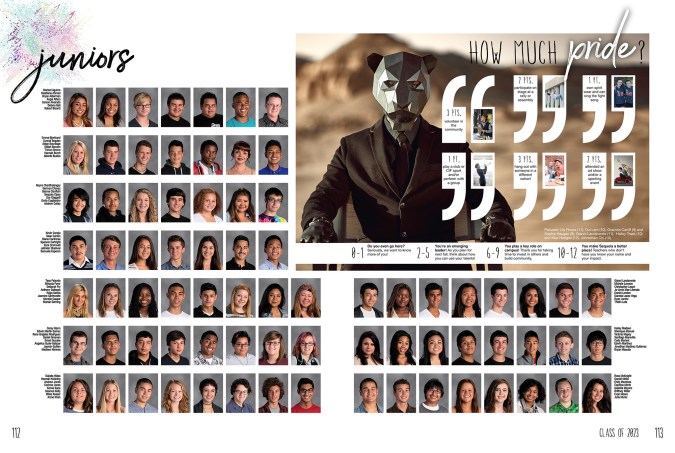
Make it Your Own
For your spirit quiz, determine which activities and behaviors define your student body and assign a point value. For example:
- Owning spirit wear +1
- Participating in a club +2
- Attending a musical or a sporting event +3
- Knowing the lyrics to the fight song or alma mater +3
- Serving the community+3
Use the scoring to affirm your community, even if it's a one or two. A simple "we want to know you more" will go far for students trying to find their way.
3. Then and Now
We’ll save the yearbook-as-public-record soapbox for another blog. Know this: anniversary years are a great time to reflect on where your school community has been and where you are headed. Schools also use building projects, campus splits, and expansion projects to add reflective photos and copy to their yearbook pages. Does this sound overwhelming? A show-stopper spread in your theme copy or your people section is all you need.
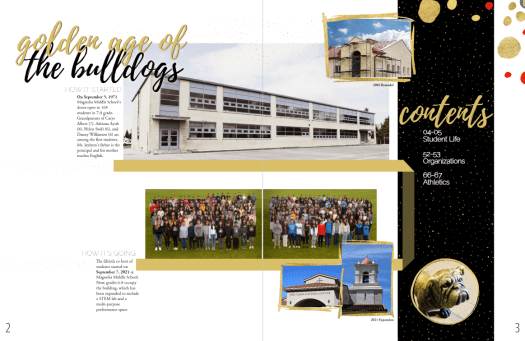
In addition to featuring changes in the building, you can write about or share photographs from
- Teachers and coaches who are alumni
- Current students of alumni
- Famous alumni (ICYMI: alumni are a huge resource)
- The local historical society
- Past yearbooks
- Blueprints
4. Pet Spread
If you’re new to crowdsourcing, or in need of additional coverage, start with a pet spread. If we’ve learned anything from #caturday and #dogsofinstagram, it’s that sharing pet photos brings us joy and is a natural part of our culture. Case in point, when our design team asked the Treering staff to submit photos of their children and pets to use in sample spreads, the latter had nearly twice the submissions.

When your students crack their yearbooks open in five or 15 years, the sight of their furry, feathered, or scaly friend beside their artwork and activities truly captures a moment in time.
5. Art Showcase Pages
Student contributions extend beyond the field, club meetings, and stage. Those creative moments in the studio or during classroom art time belong on your yearbook pages. Also, like a pet spread, an art spread is a way to include those camera-shy students.
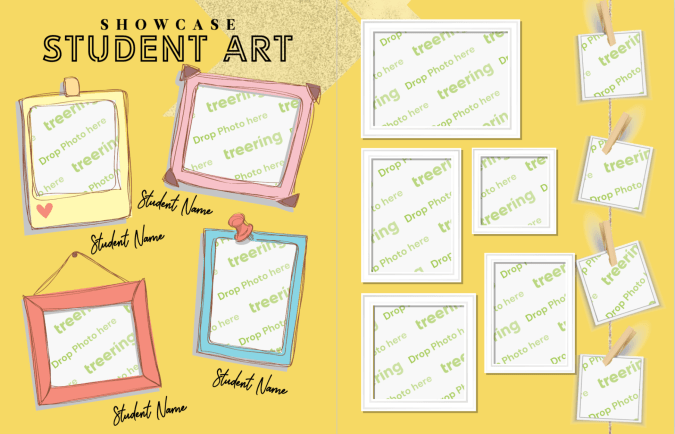
6. Fashion Page
Expression isn’t limited to canvas and ink: Yearbook Hero Grace Montemar said her school included a fashion spread because it “allowed Yearbook Club to spotlight classmates from various grades whose fashion sense stood out from the crowd.” Featured students expressed their style and their inspiration with interviews.
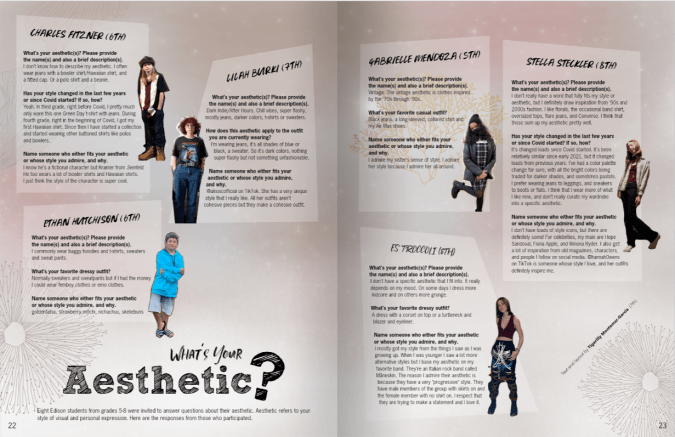
We love how this school asked students from each grade level to come to the photoshoot in a white shirt and jeans.

Do you have more easy ideas to fill pages? Share them via social and tag us!

Yearbook proofing tools
Raise your hand if you do your best proofing after the yearbook goes to print. We've all had that cringe moment when you notice two baseball players' names interchanged in the sports section or the student who joined the second semester flowed with the wrong class. We can all agree: proofing is critical for the yearbook creation process. Consistency and the proper tools will help you ensure no mistakes slip through the cracks.
One-Time: Printed Proof
Would you like a copy of your yearbook before distribution day to check your fonts, colors, layout, cover texture, and photo quality? We've got you.
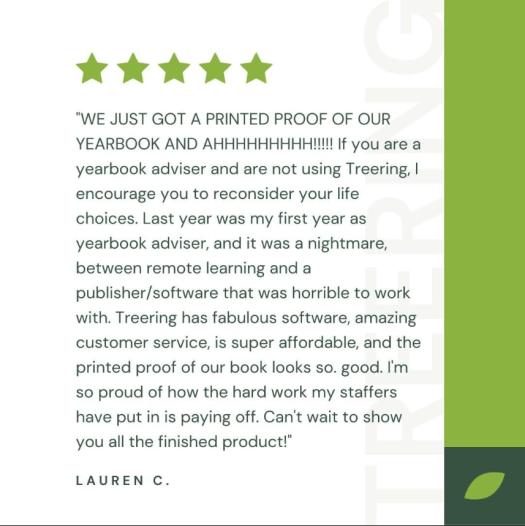
Once your yearbook is approximately 70% complete, order a printed proof of your yearbook to review the following:
- Cover alignment and bleed
- Portraits (accuracy, name size, and font)
- Gutter
- Bleed and margins
- Font choices, sizes, and colors
- Background contrast
- Spelling and attribution
- Photo clarity and color

Monthly: Use PDF Proofs
Print out a hard copy. Errors that are missed on the screen often jump out on paper. Create PDF proofs of class, event, club, and athletic pages to provide to the appropriate stakeholders for their review. Ask them:
- Is the content accurate? Is anything missing?
- Are names spelled correctly and referencing the correct person?
- Do these photos accurately represent the page's content and our student body?
Remember they need some time to review it, and should it require changes, you will need time to incorporate them.
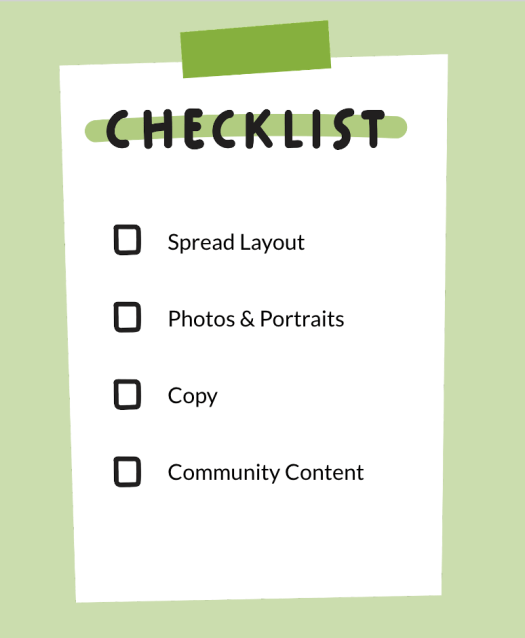
Text Proofreading Tips
Read all captions, pull quotes, and headlines out loud. It may feel silly, and once you do it, you will see and hear the value:
- Tone, word choice, and sentence structure pop when you read them out loud
- If all your writing sounds the same, you may want to mix up sentence structure or type
Proofing Yearbook Quotes
Proofing is essential if your school uses expanded captions, pull quotes, or <gasp> senior quotes. A transcription tool for interviews, such as Otter.ai, which integrates with Google Docs, is handy for recording conversations.
Quotes must not be taken out of context. We do not alter quotations, even to correct grammatical errors or word usage. If a quotation is flawed because of grammar or lack of clarity, it may be paraphrased in a way that is completely true to the original quote. If a quote's meaning is too murky to be paraphrased accurately, it should not be used. Ellipses should be used rarely and must not alter the speaker’s meaning.
AP Style Guide
(Here's an article from CBS News and one from Slate that addresses language learners to review with your students.)
Sharing is Caring: Use Printed Proofs to Tease the Book
This isn't the first time we’ll make this suggestion, and it won't be the last.
Ongoing: Rubrics and Checklists
The best time to begin proofing yearbook spreads is after you’ve finished each page and well before you need to go to print. Informal editing can happen on screen with an editor or adviser. We also highly recommend peer editing on a projector with the whole team. Use a rubric to help guide the conversation.

Proofing and editing aren't a one-and-done thing. (Sorry not sorry!) It takes time to craft the perfect story and to create a solid layout from scratch. And if DIY is not your thing, the thousands of layout templates in the Treering library are at your disposal.

